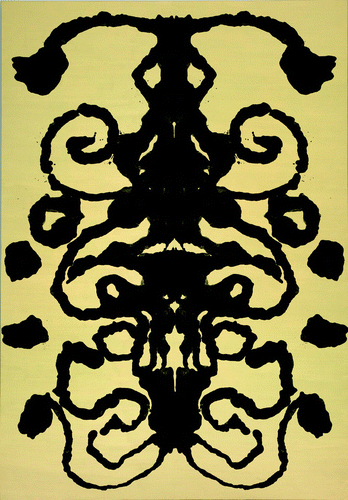Rorschach Inkblot Invasion of Pop Culture

Rorschach by Andy Warhol. Image courtesy of the Baltimore Museum of Art. © 2015 The Andy Warhol Foundation for the Visual Arts, Inc./Artists Rights Society (ARS), New York. Reproduction, including downloading of Andy Warhol works, is prohibited by copyright laws and international conventions without the express written permission of Artists Rights Society (ARS), New York.
Whether depicting mundane home goods or preeminent celebrities, Andy Warhol’s paintings capture with eerie precision the essence of American culture. This singular talent was fully evident when Warhol took aim at a burgeoning psychological phenomenon with his Rorschach series. By the 1980s, the Rorschach test had become an iconic symbol of psychological testing—a well-known metric of madness. This pop status was evident in the 1986 Watchmen graphic novel, with its psychopathic, ink-blot-masked protagonist named Rorschach. With this notorious mystique, the Rorschach test was a fitting subject for Warhol to canonize on canvas. However, the precise form these paintings would assume is not self-evident. On the basis of Warhol’s prior pop art, one may have expected to see galleries lined with inkblots like so many soup cans or Brillo boxes. Had Warhol been aware that the Rorschach test was a standardized set of 10 blots, we would likely have been treated to iridescent “4 panels” featuring precise replications of the blots. Instead, Warhol believed that during psychological testing, subjects were tasked with creating their own blots (1). Consequently, he and his crew crafted original blots, inviting us all to analyze their, and perhaps our own, psyches.
Warhol’s Rorschach painting on display in the Baltimore Museum of Art is a towering piece that dominates the gallery, the black inkblot contrasting sharply against a golden canvas. Warhol utilized the perfect symmetry that Rorschach found to be critical in having subjects consistently find objects and meaning in his blots. Rorschach made scrupulous adjustments to the actual contours of his blots, making them especially adept at inducing pareidolias (the perception of objects in amorphous shapes) (2). Objects seem to leap out of the Rorschach blots in the blink of an eye. In contrast, Warhol’s painting is so intricate that trying to find objects within it is almost maddening. As one begins to see the head of a bug, its pincers become the eyes of a troll. This process repeats itself over and again across the ornate tendrils, thick trunks, and jagged islands that make up the piece. And because of its massive proportions, taking the object in as a whole is nearly impossible. As with so much of his pop art, Warhol managed to transform the familiar into something entirely new. His spin on the inkblot continues to invite the viewer to imagine and create. But with its unruly size and unforgiving contours, Warhol’s painting has robbed the blot of the clinical utility that Hermann Rorschach so meticulously endeavored to create.
1 : Andy Warhol’s Rorschach test. Arts Magazine 1986; 61:28–29Google Scholar
2 : Revisiting the Rorschach ink-blots: from iconography and psychology to neuroscience. J Neurol Neurosurg Psychiatry 2014; 85:699–706Crossref, Medline, Google Scholar



